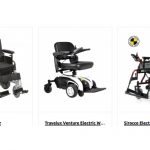Originally invented after the great war, the electric wheelchair has become fairly commonplace in our everyday lives. This is largely thanks to the innovative inventor George Klein, an employee of the National Research Council of Canada who helped veterans injured in World War II and recognised the need for a powered mobility device so invented the electric wheelchair. Since then the original design has been modified and modified again and has spawned many different types of electric wheelchair with features adapted to suit a range of different needs. Let’s take a look.
Types of electric wheelchair
There are essentially four main types of electric wheelchair which can be differentiated by their number of driving wheels including: center, rear, four wheel or front wheel drive. Each type of wheelchair has its own handling characteristics including the type of seating arrangement.
Some electric wheelchairs appear very similar to self propelled wheelchairs and have a frame and regular sling-type seat while others look like a captain's chair with a car type seat over the motor housing.
View our range of electric wheelchairs here
There are portable and small sized electric wheelchairs that have arrived in the past few years which are easily folded for transportation which are proving to be very popular and typically suit occasional indoor use as they are less powerful and have a limited range due to their battery size. However, electric wheelchairs are manufactured for indoor, outdoor or both.
Wheelchair users who suffer from shoulder, arm or hand disorders opt for electric wheelchairs to maintain their independence and freedom. Others, who have sufficient upper body strength and functionality tend to use self propelled wheelchairs to maintain exercise and fitness and to avoid the limitations that an electric wheelchair imposes, including added weight and reliance on recharging the wheelchair batteries.
Powerchair sizes and practicality
As electric wheelchair design has developed so have the control devices that are available. Joystick controllers allow the wheelchair user to maneuver themselves controlling both direction and speed. When a user has lost use of their fingers or hands, there are other methods available to operate the wheelchair.
These methods vary and include chin controls or sip and puff scanners for people with severe spinal cord injury. However, these controllers are not only fragile but very expensive. Other additional features you may like to consider include electrically powered leg raising, tilting, reclining, elevation of the seat as well as other functionalities to improve seating posture and overall user comfort which is essential as sometimes there electric wheelchairs are in use all day.
Electric wheelchair batteries
Which brings us finally on to the batteries used to power the electric wheelchairs. Battery technology has come on a long way in recent years and in basic terms they are lighter, smaller and last longer ! making them ideal power units for electric wheelchairs. With two motors and two batteries, some electric wheelchairs have a range of up to 25 miles on a single charge. This makes a great deal of difference to many users who want as much freedom as possible and like to roam further afield than just the local shops.
When you select your electric wheelchair be sure to consider the battery type and specification. If you plan to travel using aircraft then you also need to consider the regulations regarding batteries as many airlines will only allow gel filled or AGM types which are non spillable and approved for transportation both by air and by sea.
If you need to improve access to and within your home why not look at the wheelchair ramps, some are suitable for electric wheelchair and will cater for their increased weight, make sure to include the total weight of the user plus the chair to ensure that the wheelchair ramp is strong enough. These telescopic wheelchair channel ramps are suited to a total weight of 200 KG's.

